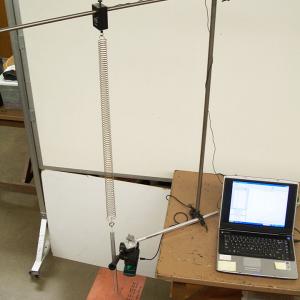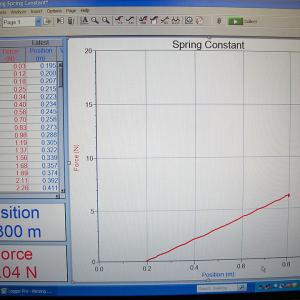College of Liberal Arts & Sciences
1R10.10 - Hooke's Law Demo
When using the large springs at least 500 grams will need to be applied before they become linear. After that at least 3 - 1 kg masses may be applied to the spring with linear results. These may be measured with one of the meter sticks with large lettering.
A backboard with markings on it may be used for a more visual display of the displacement, although this probably will not work well in the two large lecture rooms due to the seating elevation.
- Leander Perez, Adriana Marques, Ivan Sanchez, "Experimenting with Inexpensive Plastic Springs", TPT, Vol. 52, # 5, May 2014, p. 281.
- Jonathan Hall, "More Smartphone Acceleration", TPT, Vol. 51, # 1, Jan. 2013, p. 6.
- Jochen Kuhn, Patrik Vogt, "Analyzing Spring Pendulum Phenomena with a Smart-Phone Acceleration Sensor", TPT, Vol. 50, # 8, Nov. 2012, p. 504.
- Kenneth A. Pestka II, Cori Warren, "Hooke's Law and the Stiffness of a Plastic Spoon", TPT, Vol. 50, #8, Nov. 2012, p. 470.
- Nicolas Silva, "Studying Hooke's Law by Using a Pogo Stick", TPT, Vol. 49, # 5, May 2011, p. 300.
- Terrence P. Toepker, "Center of Mass of a Suspended Slinky: An Experiment", TPT, Vol. 42, # 1, Jan 2004, p. 16.
- Fabio Menezes de Souza Lima, Gustavo Mulim Venceslau, and Eliana dos Reis Nunes, "A New Hook's Law Experiment", TPT, Vol. 40, # 1, p. 35, Jan. 2002.
- Lawrence Rugy, "Equivalent Mass of a Coil Spring", TPT, Vol. 38, # 3, p. 140, March 2000.
- Robert Weinstock, "Previous Coil Springs", TPT, Vol. 38, # 5, p. 259, May 2000.
- Peter Froehle, "Reminder About Hooke's Law and Metal Springs", TPT, Vol. 37, # 6, p. 368, Sept. 1999.
- Glenn Wagner, "Linearizing a Nonlinear Spring", TPT, Vol. 33, # 9, p. 566- 567, Dec. 1995.
- R.D. Edge, "Mechanical Intuition Can Be Wrong", TPT, Vol. 30, # 8, Nov. 1992, p. 511.
- Jim Glaser, ""A Jolly Project for Teaching Hooke's Law", TPT, Vol. 29, # 3, Mar. 1991, p. 164.
- Brian S. Berry, "Atomic Diffusion and the Breakdown of Hook's Law", TPT, Vol. 21, # 7, Oct. 1983, p. 435.
- R. M. Prior, "A Nonlinear Spring", TPT, Vol. 18, # 8, Nov. 1980, p. 601.
- Francis W. Sears , "Functional Dependence of Elongation of a Coil Spring on the Load Applied", TPT, Vol. 4, # 2, Feb. 1966, p. 84.
- A. Filipponi, L. Di Michele, C. Ferrante, "Viscoelastic Behavior of a Mass-Rubber Band Oscillator", AJP, Vol. 78, # 4, April 2010, p. 437.
- Timothy J. Folkerts, "A More General Form for Parallel Springs", AJP, Vol. 70, # 5, May 2002, p. 493.
- F. M. Fyfe et al., "Large-Scale Spring Experiment", AJP, Vol. 49, #11, Nov. 1981, p. 1074.
- John Thomchik, J. P. McKelvey, "Anharmonic Vibration of an "Ideal" Hooke's Law Oscillator", AJP, Vol. 46, # 1, Jan. 1978, p. 40.
- H. L. Armstrong, "The Oscillating Spring and Weight - An Experiment Often Misinterpreted", AJP, Vol. 37, #4, Apr. 1969, p. 447.
- JC Iñiguez, et al., "A Vertical Mass-Spring System is Proved to be Ideal", Physics Education, Vol. 40, # 4, July 2005, p. 318.
- Mx- 3, 7: Freier and Anderson, A Demonstration Handbook for Physics.
- John L. Roeder, Activity 3, "Dependence of Elastic Energy on Position", Teaching About Energy, p. 32.
- Jearl Walker, "1.148, A Two-Spring Surprise", The Flying Circus of Physics Ed. 2, p. 70.
- Julius Sumner Miller, Q6 & A6, Millergrams I – Some Enchanting Questions for Enquiring Minds, p. 18 & 77.
- Julius Sumner Miller, Q140 & A140, Millergrams II – Some More Enchanting Questions for Enquiring Minds, p. 25 & 85.
Disclaimer: These demonstrations are provided only for illustrative use by persons affiliated with The University of Iowa and only under the direction of a trained instructor or physicist. The University of Iowa is not responsible for demonstrations performed by those using their own equipment or who choose to use this reference material for their own purpose. The demonstrations included here are within the public domain and can be found in materials contained in libraries, bookstores, and through electronic sources. Performing all or any portion of any of these demonstrations, with or without revisions not depicted here entails inherent risks. These risks include, without limitation, bodily injury (and possibly death), including risks to health that may be temporary or permanent and that may exacerbate a pre-existing medical condition; and property loss or damage. Anyone performing any part of these demonstrations, even with revisions, knowingly and voluntarily assumes all risks associated with them.

